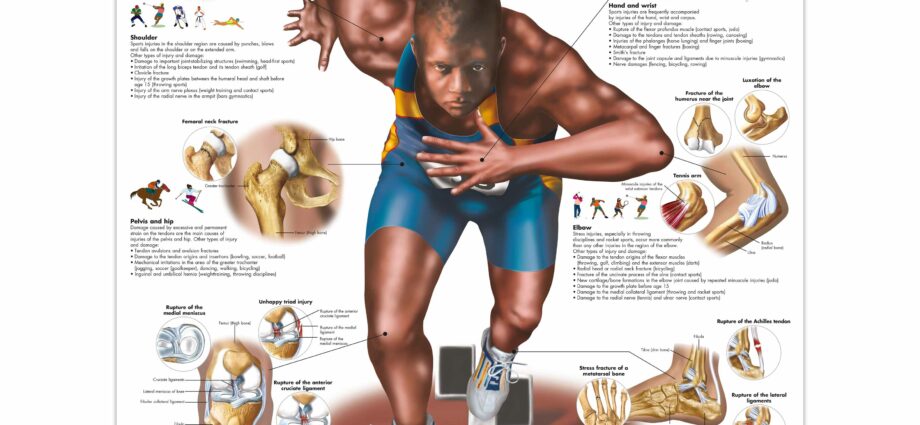Muscle injuries (sports)
We have gathered here different types of muscle injuries – from cramping to the complete rupture of a muscle – which can occur in the practice of a sports activity, whether you are a beginner, experienced athlete, competitor or high level practitioner. These injuries especially concerning the lower limb (thigh and calf muscles) as well as the adductors, can compromise the leisure sporting activity or the competition objectives of an athlete. The management of muscle injuries has 3 important objectives:
Each year, approximately 9% of all Quebecers aged 6 to 74 participating in a sport or leisure activity suffer an injury requiring consultation with a health professional.1. (This statistic includes all types of accidental injuries, including fractures.) |
Types of muscle injuries
There are several types of muscle injuries, depending on the circumstances and context of the accident and the data of the interview and clinical examination.
- Cramps : it is not strictly speaking a muscle injury but rather a temporary dysfunction. The cramp corresponds in fact to an extremely painful, involuntary and transient contraction, similar to a crushing touching one or more muscles. It can occur at rest, during sleep or during exertion. The origin of cramps occurring in a sporting context is complex. They would be the result of an insufficient supply of oxygen or blood electrolytes, or ofan accumulation of toxins linked to exertion. They can be consecutive to a muscle exhaustion or to one Dehydration.
- Contusion : it is the consequence of a direct trauma on a muscle most often in the contraction phase or at rest. It is manifested by pain localized at the point of impact, by swelling and sometimes a bruise (hematoma or cloudiness of blood under the skin following a rupture of the vessels, colloquially called blue). These manifestations are all the more important and deep as the initial trauma is intense.
- Elongation : this is the first stage of muscle damage. It corresponds to an excessive lengthening of the muscle. Elongation occurs during a excessive stress muscle or as a result of too strong a contraction. Some muscle fibers are stretched and break. it is therefore a very limited, even “microscopic” tear. The elongation is manifested by exertional pain causing neither lameness nor hematoma. The injured person feels a sharp pain, like a prick, during a start for example or on a badly warmed up or tired muscle. The effort is still possible although a little painful. The muscles of the quadriceps (anterior thigh muscle) andback thigh (the hamstrings) are the most likely to experience a strain. The practice of sport is still possible but painful.
- breakdown : breakdown also corresponds to an elongation mechanism in which many fibers have been broken and bleed. The pain is sharp, similar to a stab in the muscle. A clacking sensation is sometimes felt, hence the term “clacking”. We also speak of stage 2 tearing. At the breakdown stage, sporting activity is no longer possible. Walking is also made difficult.
- Tearing : Muscle tear is similar to a muscle fracture, like a bone fracture. The pain is such that it sometimes causes discomfort and a fall. The tears mainly concern the hamstrings, adductors and calves (“tennis leg”). The support on the limb is very difficult and the continuation of sporting activity has become impossible. The bleeding is heavy and a hematoma does not take long to appear.
In reality, all the intermediaries are possible between simple elongation, small strain and tear and the exact classification of the muscular lesion can be difficult to appreciate by the only clinical examination. Hence the interest of ultrasound and MRI (magnetic resonance imaging) which constitute the examinations of choice when it comes to making a precise diagnosis or measuring the lesion, in particular for the diagnosis of tears.
The muscle The main characteristic of a muscle is its ability to contract by producing movement. Its classic representation shows us a swollen muscle tissue in the middle, which continues at the ends by 2 tendons. It is made up of several fibers, thin, long (some are the length of the muscle), arranged parallel, grouped in bundles and separated by connective tissue. This fibrous framework allows the shortening of the muscle, synonymous with movement. But contrary to popular belief, muscles are not only dedicated to movement or gestural activity. Indeed, many muscles solicited at rest; this is called the Muscle tone allowing for example the standing position. |
Causes of muscle damage
As we have seen, the vast majority of muscle damage concern the lower limbs (thigh and leg) and are often consecutive to the practice of a sport, mainly contact sports (football, hockey, boxing, rugby, etc.), acrobatic sports (snowboarding, skateboarding, etc.) and those requiring quick starts (tennis, basketball, sprinting, etc.) etc.). Muscle injuries can be observed:
- En start of the year: overtraining (excessive training) or insufficient training, insufficient or poor warm-up, poor sporting gesture, etc.
- En end of year: fatigue, lack of flexibility of the muscle.
- During exercise : poor quality sporting gesture, sudden, violent and uncoordinated movements, especially if there is an imbalance between the strength of the agonist muscles (which make the movement) and that of the antagonist muscles (which do the opposite movement) – for example, the biceps and triceps, quads and hamstrings.
- In a direct trauma with a hard object (crampon, knee of another athlete, pole, etc.).
- Because of a too intense or prolonged effort.
- Because of a poorly healed anterior muscle injury.
- In case of overweight.
- When using a unsuitable training equipment (shoes in particular …).
- Due to a too hard training surface (bitumen, concrete…).
- In the absence of sufficient hydration, before, during or after exercise.
- When the power supply is inadequate.
- In the absence of stretching after the effort and more generally, insufficient muscle stretching compared to muscular demands.
- During an effort in a cold environment.










